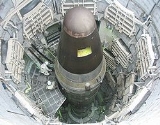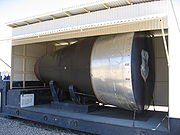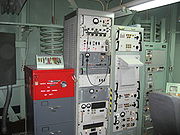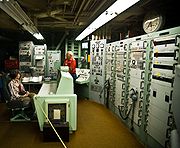
Titan Missile Museum
Encyclopedia
The Titan Missile Museum, also known as Air Force Facility Missile Site 8 or as Titan II ICBM Site 571-7, is a former ICBM missile site located at 1580 West Duval Mine Road, Sahuarita
, Arizona
. It is located about 15 miles south of Tucson
. It is now a museum run by the nonprofit Arizona Aerospace Foundation which includes an inert Titan II intercontinental ballistic missile
in the silo, as well as the original launch facilities.
It was declared a National Historic Landmark
in 1994.
, the eight level silo containing the missile and its related equipment, and the connecting structures of cableways (access tunnels), blast locks, and the access portal and equipment elevator. The complex was built of steel reinforced concrete with walls as much as 8 feet (2.4 m) in some areas, and a number of 3-ton blast doors sealed the various areas from the surface and each other.
The top level of the silo permits viewing the silo missile doors. Level 3 houses a large diesel generator. Level 7 provides access to the lowest part of the launch duct. Visitors on the "Beyond the Blast Doors" tour are allowed to stand directly underneath the missile. Level 8, at 140 feet underground, houses the propellant pumps.
, even at rest, are highly toxic, although the reasons may not be obvious. An inactive warhead is relatively harmless compared to the propellant used to launch the missile into space. The unique nature of the Sahuarita missile site is that all the original equipment is intact. The missile in the silo was used solely for crew training. Fuel was never loaded in the missile. The silo originally held an active nuclear missile, but the training missile replaced it when the facility was converted to a museum.
The 103 feet (31.4 m) Titan II missile inside the silo has neither warhead nor fuel. In accordance with a US/USSR agreement, the silo doors are permanently blocked from opening more than half way. The dummy reentry vehicle mounted on the missile has a prominent hole cut in it to prove it is inert. All of the support facilities at the site remain intact, complete with all of their original equipment.
The silo became operational in 1963 and was deactivated in 1982 as part of President Reagan
's policy (announced in 1981) of decommissioning the Titan II missiles. It is a common misconception that this was the result of a weapons reduction treaty, but was in fact simply part of a weapon systems modernization program. All operational Titan II silos throughout the country were demolished, including 18 sites around McConnell AFB in Wichita, Kansas, 17 sites around Little Rock AFB, Arkansas (one additional site previously damaged beyond repair in a mishap/non-nuclear explosion) and 17 other sites around Davis-Monthan AFB and Tucson, except for this one. It is now a National Historic Landmark.
 The Titan II was the largest operational land based nuclear missile ever used by the United States. The missile had one W53 warhead with a yield of 9 Megatons (9,000 kilotons).
The Titan II was the largest operational land based nuclear missile ever used by the United States. The missile had one W53 warhead with a yield of 9 Megatons (9,000 kilotons).
The facility's highest state of alert was November 22, 1963, when President John F. Kennedy
was shot
. When news of the shooting broke, the keys used to launch the missile were ordered to be placed on the tables at the launch consoles to prepare for a possible launch. The Pentagon
did not yet know whether the Soviet Union
had committed an act of war. The keys were not, however, placed in their switches.
At launch, orders from the National Command Authority would have specified one of three pre-programmed targets which, for security reasons, were unknown to the crew. The missile base that is now the Titan Missile Museum (complex 571-7 of the 390th Strategic Missile Wing) was at the time of closure, programmed to strike "Target Two". The missiles computer could hold up to three targets, and the target selected was determined by Strategic Air Command headquarters. To change the selected target, the crew commander pressed the appropriate button on the launch console. Target 2, which is classified to this day but was assumed to be within the borders of the former Soviet Union, was designated as an impact blast, suggesting that the target was a hardened facility such as a Soviet missile base. Targets could be selected for air or ground burst, but the selection was determined by Strategic Air Command.

 At the visitor center there is a small gift shop and a small museum putting the Titan II within the context of the Cold War. The basic tour starts with a short video on the history of the Titan II and the launch complex. Then everyone dons provided hard hats to protect visitors against the low-hanging steel and concrete equipment. The tour moves outside for a guided tour of the surface features of the complex including the hardstands for fuel storage containers and associated control vehicles. There are also restored engines (both stages) from a Titan II missile, and a re-entry vehicle. The silo door is permanently blocked in the half-open position, with the open portion covered with glass panels to protect the missile and silo from the weather while allowing a dramatic view of the silo interior and the missile from the top.
At the visitor center there is a small gift shop and a small museum putting the Titan II within the context of the Cold War. The basic tour starts with a short video on the history of the Titan II and the launch complex. Then everyone dons provided hard hats to protect visitors against the low-hanging steel and concrete equipment. The tour moves outside for a guided tour of the surface features of the complex including the hardstands for fuel storage containers and associated control vehicles. There are also restored engines (both stages) from a Titan II missile, and a re-entry vehicle. The silo door is permanently blocked in the half-open position, with the open portion covered with glass panels to protect the missile and silo from the weather while allowing a dramatic view of the silo interior and the missile from the top.
The below ground tour starts with a walk down several flights of stairs totaling some 55 steps. Arrangements can be made for handicapped access utilizing the freight elevator. The standard tour includes a visit to the control room through the controlled access entrance including a set of 3-ton blast doors. The visit to the control room includes a simulated launch - a demonstration of the steps that would have been taken to launch the missile. Then a comfortable walk through the cableway (tunnel) to the silo to the view the missile and silo from lower down.
The basic tour takes about one hour. (After returning to the surface on the guided tour, you are welcome to spend as much time as you like studying the surface areas more closely if you wish.) Special behind the scenes tours are also available. The extended tours allow access to the upper and lower levels of the control center, as well as the various other levels of the silo, antenna silos and other site features. Extended tours can take 4 to 5 hours. The museum also offers some special overnight tours on a very limited basis. The extended tours are available by reservation only. More information can be found and reservations may be made via the museum web site.
Several scenes in the 1996 film Star Trek: First Contact
were shot at the site. The missile itself was depicted to be the launch vehicle for the film's Phoenix spacecraft.
Sahuarita, Arizona
Sahuarita is a town in Pima County, Arizona, United States. Sahuarita is located south of the Tohono O'odham Nation and abuts the north end of Green Valley, 15 miles south of Tucson...
, Arizona
Arizona
Arizona ; is a state located in the southwestern region of the United States. It is also part of the western United States and the mountain west. The capital and largest city is Phoenix...
. It is located about 15 miles south of Tucson
Tucson, Arizona
Tucson is a city in and the county seat of Pima County, Arizona, United States. The city is located 118 miles southeast of Phoenix and 60 miles north of the U.S.-Mexico border. The 2010 United States Census puts the city's population at 520,116 with a metropolitan area population at 1,020,200...
. It is now a museum run by the nonprofit Arizona Aerospace Foundation which includes an inert Titan II intercontinental ballistic missile
Intercontinental ballistic missile
An intercontinental ballistic missile is a ballistic missile with a long range typically designed for nuclear weapons delivery...
in the silo, as well as the original launch facilities.
It was declared a National Historic Landmark
National Historic Landmark
A National Historic Landmark is a building, site, structure, object, or district, that is officially recognized by the United States government for its historical significance...
in 1994.
Underground Facilities
The underground facilities consist of a three-level Launch Control CenterLaunch control center (ICBM)
A launch control center , in the United States, is the main control facility for intercontinental ballistic missiles . A launch control center monitors and controls missile launch facilities. From a launch control center, the missile combat crew can monitor the complex, launch the missile, or relax...
, the eight level silo containing the missile and its related equipment, and the connecting structures of cableways (access tunnels), blast locks, and the access portal and equipment elevator. The complex was built of steel reinforced concrete with walls as much as 8 feet (2.4 m) in some areas, and a number of 3-ton blast doors sealed the various areas from the surface and each other.
The top level of the silo permits viewing the silo missile doors. Level 3 houses a large diesel generator. Level 7 provides access to the lowest part of the launch duct. Visitors on the "Beyond the Blast Doors" tour are allowed to stand directly underneath the missile. Level 8, at 140 feet underground, houses the propellant pumps.
Titan II missile
Nuclear missilesIntercontinental ballistic missile
An intercontinental ballistic missile is a ballistic missile with a long range typically designed for nuclear weapons delivery...
, even at rest, are highly toxic, although the reasons may not be obvious. An inactive warhead is relatively harmless compared to the propellant used to launch the missile into space. The unique nature of the Sahuarita missile site is that all the original equipment is intact. The missile in the silo was used solely for crew training. Fuel was never loaded in the missile. The silo originally held an active nuclear missile, but the training missile replaced it when the facility was converted to a museum.
The 103 feet (31.4 m) Titan II missile inside the silo has neither warhead nor fuel. In accordance with a US/USSR agreement, the silo doors are permanently blocked from opening more than half way. The dummy reentry vehicle mounted on the missile has a prominent hole cut in it to prove it is inert. All of the support facilities at the site remain intact, complete with all of their original equipment.
The silo became operational in 1963 and was deactivated in 1982 as part of President Reagan
Ronald Reagan
Ronald Wilson Reagan was the 40th President of the United States , the 33rd Governor of California and, prior to that, a radio, film and television actor....
's policy (announced in 1981) of decommissioning the Titan II missiles. It is a common misconception that this was the result of a weapons reduction treaty, but was in fact simply part of a weapon systems modernization program. All operational Titan II silos throughout the country were demolished, including 18 sites around McConnell AFB in Wichita, Kansas, 17 sites around Little Rock AFB, Arkansas (one additional site previously damaged beyond repair in a mishap/non-nuclear explosion) and 17 other sites around Davis-Monthan AFB and Tucson, except for this one. It is now a National Historic Landmark.
Yield and warhead

The facility's highest state of alert was November 22, 1963, when President John F. Kennedy
John F. Kennedy
John Fitzgerald "Jack" Kennedy , often referred to by his initials JFK, was the 35th President of the United States, serving from 1961 until his assassination in 1963....
was shot
John F. Kennedy assassination
John Fitzgerald Kennedy, the thirty-fifth President of the United States, was assassinated at 12:30 p.m. Central Standard Time on Friday, November 22, 1963, in Dealey Plaza, Dallas, Texas...
. When news of the shooting broke, the keys used to launch the missile were ordered to be placed on the tables at the launch consoles to prepare for a possible launch. The Pentagon
The Pentagon
The Pentagon is the headquarters of the United States Department of Defense, located in Arlington County, Virginia. As a symbol of the U.S. military, "the Pentagon" is often used metonymically to refer to the Department of Defense rather than the building itself.Designed by the American architect...
did not yet know whether the Soviet Union
Soviet Union
The Soviet Union , officially the Union of Soviet Socialist Republics , was a constitutionally socialist state that existed in Eurasia between 1922 and 1991....
had committed an act of war. The keys were not, however, placed in their switches.
At launch, orders from the National Command Authority would have specified one of three pre-programmed targets which, for security reasons, were unknown to the crew. The missile base that is now the Titan Missile Museum (complex 571-7 of the 390th Strategic Missile Wing) was at the time of closure, programmed to strike "Target Two". The missiles computer could hold up to three targets, and the target selected was determined by Strategic Air Command headquarters. To change the selected target, the crew commander pressed the appropriate button on the launch console. Target 2, which is classified to this day but was assumed to be within the borders of the former Soviet Union, was designated as an impact blast, suggesting that the target was a hardened facility such as a Soviet missile base. Targets could be selected for air or ground burst, but the selection was determined by Strategic Air Command.
Tours


The below ground tour starts with a walk down several flights of stairs totaling some 55 steps. Arrangements can be made for handicapped access utilizing the freight elevator. The standard tour includes a visit to the control room through the controlled access entrance including a set of 3-ton blast doors. The visit to the control room includes a simulated launch - a demonstration of the steps that would have been taken to launch the missile. Then a comfortable walk through the cableway (tunnel) to the silo to the view the missile and silo from lower down.
The basic tour takes about one hour. (After returning to the surface on the guided tour, you are welcome to spend as much time as you like studying the surface areas more closely if you wish.) Special behind the scenes tours are also available. The extended tours allow access to the upper and lower levels of the control center, as well as the various other levels of the silo, antenna silos and other site features. Extended tours can take 4 to 5 hours. The museum also offers some special overnight tours on a very limited basis. The extended tours are available by reservation only. More information can be found and reservations may be made via the museum web site.
Several scenes in the 1996 film Star Trek: First Contact
Star Trek: First Contact
Star Trek: First Contact is the eighth feature film in the Star Trek science fiction franchise, released in November 1996, by Paramount Pictures. First Contact is the first film in the franchise to feature no cast members from the original Star Trek television series of the 1960s...
were shot at the site. The missile itself was depicted to be the launch vehicle for the film's Phoenix spacecraft.
External links
- Titan Missile Museum
- Pima Air & Space Museum
- Aerial photo of site of Titan Missile Museum
- Color aerial photo of Titan Missile Museum
- NPR: Missile Museum Sparks Cold War Memories (February 9, 2007)
- NYT: Strange Love (January 5, 2007)
- Aviation: From Sand Dunes to Sonic Booms, a National Park Service Discover Our Shared Heritage Travel Itinerary

